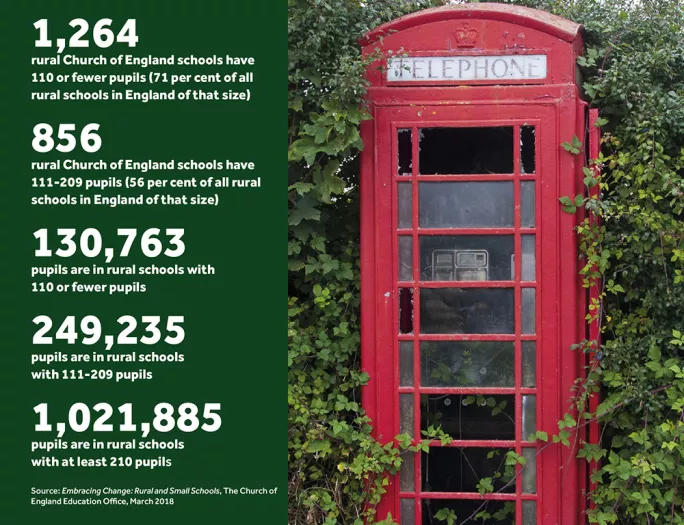Do we need a village school preservation society?

Two years ago, the government made a promise: in the future, it would be harder to close small rural schools.
With their pretty old buildings, nurturing atmospheres and close links to the community, they have been part of the fabric of English rural life for generations. And as village pubs, shops and post offices have gradually faded away, the school has taken on ever greater importance in holding communities together. For many, the news that they would receive greater protection was a relief.
But despite official reassurances, their existence may now be in more danger than ever.
“My vision of the future is that small schools will continue to disappear and few will be left, as time passes,” says Mervyn Benford, a former small-school head and information officer of the National Association of Small Schools, who warns of an “all embracing” storm.

And there is growing evidence that his fears are justified. The traditional village primary school is facing threats from several directions:
* The Church of England (CofE), which is lobbying the government to change the rules to make it easier for it to close small schools.
* Multi-academy trusts (MATs) that close small schools after schools have joined them.
* Regional schools commissioners (RSCs) who want to impose a minimum number of pupils to ensure schools are “viable”.
* The new national funding formula (NFF), which critics fear will accelerate the closure of small schools.
* MATs refusing to take on vulnerable small schools, which are then being closed.
Benford is not alone in fearing for their future. In April, delegates at the last ever NUT teaching union conference were so concerned that they called for the government to give rural schools “protected status”, while Valentine Mulholland, head of policy at the NAHT headteachers’ union, warns of “an accelerated rate of closures” if nothing is done.
And it matters beyond the school gates, as Russell Clark, chair of governors of Milburn School, a primary in the Cumbrian hills with just six pupils, explains: “We don’t have a shop. We don’t have a pub. We don’t really have public transport. We have a school, a village hall and a church, and we are integrated into the village. It’s very important; it’s part of the village.”
The future of small schools such as Clark’s were already clouded by a potent mix of challenges, including inflexible Victorian buildings that are expensive to heat and maintain; falling rolls caused by rural depopulation; and problems with recruiting high-quality teachers and leaders. But now some also face a direct threat from church and state.
In this story, the CofE is a key player, thanks to its historic role in developing schooling in England, long before a state education system came into existence. Its National Society, which aimed to open a church school in every parish, was founded in 1811, at a time when almost two-thirds of England’s population was rural.
Now, after two centuries that have heralded a decisive population shift to urban areas, this legacy leaves it responsible for more than two-thirds of “very small” rural primary schools, which it defines as those with fewer than 110 pupils.

It is an issue that the church is acutely aware of. In March it published Embracing Change: Rural and Small Schools, a 46-page document that updates an approach it last articulated four years ago. The new vision seeks to adapt to a world where academy trusts have become more important, and in which funding is tighter than ever.
The document re-emphasises the organisation’s 2014 conclusion that “small rural schools could not continue to operate as standalone units”, and stresses a need for them to “come together in formal groupings”. But while it puts forward a positive vision to preserve rural education, there is stark recognition of the necessity of closure.
“Where a school’s budget is under pressure and numbers on roll are low, it can be difficult to justify a decision to keep a school open when significant investment would be required to bring the building up to standard,” it states.
More than that, the document urges the government to change the rules in a way that would make it easier to close small rural schools.
In law, there is a presumption against closing rural schools. Before any of these 3,806 institutions can be shut, “the likely effect of the closure of the school on the local community” must be considered, as well as the “educational standards at the school and the likely effect on standards at neighbouring schools”. But the church wants this stipulation reviewed “to ensure decision-makers focus on the educational interests of children”.
Nigel Genders, the CofE’s chief education officer, is clear that this change would reduce the weight attached to the impact on the local community. “Too often in the debate we put [educational quality] as a subsidiary question and say we don’t want to see the school lost because we have already lost the post office and the pub and the doctor’s surgery,” he says.
“I just think that’s the wrong way around, and I think we need to start by asking ‘what’s likely to give these children the best education they can have?’
“It may well be that we do that in a way that still means they can access it locally within their village. But it needs to be that way around, rather than asking ‘how do we keep this village’s last bastion as a community presence open, which is the school, irrespective of what the quality of education might be?’”
He believes the Department for Education is “very open” to the suggestion.
For Benford, the government’s current guidance “rightly requires a village impact study in closure cases”. “Sadly, recent Anglican policy wills the death of the village school as we have known it,” he says.
MATs and federations have often been held up as the saviour of small schools. Two years ago, Sir David Carter, who as national schools commissioner oversees the national academy system, hailed academy trusts as “the best and most secure place” for small schools.
The belief is that joining a bigger group provides opportunities to attract good teachers, training and specialist knowledge that the school could not afford alone, as well as financial savings by sharing higher-paid leadership positions. There are clear examples of how this approach can succeed.
But now concern about the cost of running small and isolated schools is putting many academy trusts off sponsoring them. The country’s second-biggest primary-only sponsor, the Elliot Foundation, gives preference to schools with more than 400 pupils on roll. And in North Yorkshire, Burnt Yates Primary, a village church school with just 30 pupils, is due to close for good this summer because no academy trust would sponsor it after it went into special measures.
Live and kicking?
While academy cheerleaders see academy trusts as safe havens for village primaries, the fear that they would instead sign their death warrant fuelled a Tory rebellion that prompted Nicky Morgan to abandon plans to turn every state school in England into an academy.
It was during this climb-down, in May 2016, that Ms Morgan, then education secretary, introduced a “double lock” so that small rural schools that became academies could only be closed if both local and national governments agreed. The DfE says that this lock is still in place today, but it has not stopped academy trusts seeking to close the small schools they have taken on.
More than 130 years of history at St Martin-in-Meneage Primary, on the Lizard Peninsula in Cornwall, was concluded in January when the Keskowethyans Multi Academy Trust, which it had joined four years earlier, closed the school. The number of pupils at the primary had slipped into single figures.
And the Diocese of Ely Multi-Academy Trust announced plans to close Ten Mile Bank Riverside Academy, with 34 pupils, in Downham Market, Norfolk, less than a year after taking it on, only to give it a stay of execution following a community campaign.
The problem is acute for the CofE’s diocesan academy trusts if they are to take on the large number of small, isolated church schools in their areas. How sustainable can they be if they have dozens of schools that each have premises to maintain, but only small budgets to contribute to the central pot, as well as remote locations that make collaboration difficult?
“That’s one of the challenges of the multi-academy trust model,” acknowledges Genders. He cites those who say trusts need anything from 3,000 to 10,000 pupils in their schools to be viable. “That’s a lot of schools of 100 pupils each,” Genders adds.
For him, large numbers of small schools make it much harder to achieve economies of scale. Gender says that it works better if groups of 10-15 small schools take collective decisions to join trusts.
However, Mulholland, of the NAHT, strikes a cautious note about claims for the financial benefits of such collaborations. “They can definitely bring in some efficiencies,” she says. “They can mean you are going to have a curriculum lead in one school, a school business manager in one school. But I think the government thinks that’s a panacea for the funding crisis and I’m not convinced that those efficiencies are enough to make small schools viable.”
And although some small schools can seek shelter by joining larger organisations, others question whether this undermines the very characteristics that make them special.
Out of tune
Benford says that small schools that join wider federations or academy trusts can soon find that they are being dominated by a secondary school or larger primary, and “decisions are made for a cluster that are not terribly sympathetic to the particular opportunities and culture of small schools, which are used to very much more community work and mixed-age grouping”.
It was just such a fear that led Milburn School, the Cumbrian school in which Russell Clark is chair of governors, to decide against submerging itself in a rigid federation or academy trust after it went into special measures in 2014.
With just six pupils, it is one of England’s smallest schools, but a year later it bounced back to a “good” rating. This week, it is entering into a more flexible collaboration with Beaconside Primary, which is more than 70 times bigger, that will preserve its independence.
The CofE’s blueprint, Embracing Change, also reveals the threat small schools are facing from another direction: RSCs. These are the DfE civil servants overseeing England’s academy system, charged with finding sponsors for schools that are legally required to become academies after being rated ‘inadequate’ by Ofsted.
According to the CofE’s report, some RSCs have “tried to set a minimum pupil number for schools to remain viable”. However, like the church, councils and academy trusts, they have apparently also learned how difficult a problem the future of small schooling is to solve. Embracing Change adds that RSCs “have often struggled to put any consequent reorganisations into effect”.
And then there is funding: an issue facing schools of all sizes, but that bites especially hard with the smallest. It seems like ancient history now, but only a couple of years ago there was optimism that the government’s promise to overhaul school funding would come to the rescue of rural schools by shifting money away from urban areas.
As the CofE report puts it, the hope was that the national funding formula would “lead to a reinvigoration of rural schools and a return to the funding levels of the first decade of this century”. But far from leading them to a rosy future, the NFF is now seen as a threat to their existence.
When the original NFF proposals were released, small schools were horrified when a Tes analysis showed that at least 1,101 rural schools that the DfE defined as “small” would have their budgets cut. Following the ensuing outcry, the government boosted the average funding increase for rural schools from 1.3 per cent to 3.9 per cent. But headteachers are concerned that even this is not enough.
Mulholland says rural schooling is now “the only area of the national funding formula that we think really needs looking at”.
“It’s difficult because for a small school the [annual] lump sum of £110,000 is relatively significant, but it’s not enough,” she says.
“There are particular issues for small schools that do not have high levels of deprivation, of pupils with English as an additional language or with special educational needs or disabilities.”
She is calling for a review of the NFF’s effect on small schools, adding that “there needs to be a proper recognition of the minimum cost of running a school with 100 pupils, 50 pupils.”
For its part, the DfE says it understands the financial problems that beset small rural schools, and highlights the extra money it is putting in.
“We recognise that smaller, more remote schools face different funding pressures,” says a spokesperson, “which is why, on top of record core schools funding, we have made an additional £26 million available to them.
“This means that across England, rural schools will gain an average of 3.9 per cent through the formula, with those schools in the most remote locations gaining 5 per cent.”
This may or may not be enough to protect the future of our smallest schools, but either way, the funding settlement will surely determine the face of rural England for generations to come.
You need a Tes subscription to read this article
Subscribe now to read this article and get other subscriber-only content:
- Unlimited access to all Tes magazine content
- Exclusive subscriber-only stories
- Award-winning email newsletters
Already a subscriber? Log in
You need a subscription to read this article
Subscribe now to read this article and get other subscriber-only content, including:
- Unlimited access to all Tes magazine content
- Exclusive subscriber-only stories
- Award-winning email newsletters